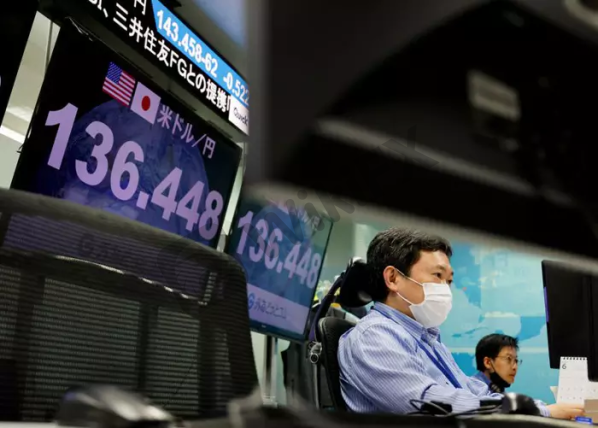
Asian shares were pinned at two-year lows on Thursday after white-hot U.S. inflation data drove fears the Federal Reserve will raise interest rates even more aggressively, which boosted the safe haven dollar.
Underscoring how inflation pressures are also hitting Asia, both the Monetary Authority of Singapore and the Bangko Sentral ng Pilipinas surprised markets by tightening monetary policy on Thursday in off cycle moves.
MSCIs broadest index of Asia-Pacific shares outside Japan was flat by early afternoon.
EUROSTOXX 50 futures gained 0.4% and S&P 500 futures reversed early losses to trade 0.1% lower.
Chinese blue chips rose 0.5% a day after data showed Chinas June exports rose at the fastest pace in five months as factories revved up after the lifting of COVID lockdowns. China will release June activity data on Friday along with second quarter GDP.
“With the prospect of the Chinese economy exiting its darkest period in Q2 into a more stable second half, and with the prospect of monetary support versus tightening in the rest of the world, Chinese stocks seem attractive in relative terms compared to other asset classes and global equities,” said Carlos Casanova, senior economist for Asia at UBP.
Nonetheless, in a sign China is not yet out of the woods, reports that a growing number of homebuyers are threatening to stop making mortgage payments caused Chinese banking and property names to fall.
Japan‘s Nikkei rose 0.7%, as the yen’s weakness against the dollar boosted exporters, and good jobs figures helped Australian stocks to gain 0.43%.
Inflation fears
Everything in Asia, however, was taking place in the shadow of U.S. data overnight showing rising costs of fuel, food and rent drove the consumer price index (CPI) up 9.1% last month.
This sparked worries that the Fed could raise rates by an enormous 100 basis points (bps) at its meeting this month rather than the 75 bps that had been expected, adding to investors fears of a possible recession.
“The concerning aspect in the CPI numbers was the breadth of increases,” said Shane Oliver, chief economist and chief investment strategist at AMP, who said nearly 90% of the U.S. CPI components saw increases of more than 3%.
Market pricing on the CMEs Fedwatch tool currently indicates a 78% chance of a 100 bps increase, though Oliver said this could be a knee-jerk reaction to the high CPI reading.
I personally think the Fed will stick to 75 – which is still a high number – if they go to 100 it will look like they are panicking.
“Only time will tell, though. The Fed does have an unconditional commitment to get inflation back down.”
U.S. two-year yields, which reflect interest rate expectations, were last at 3.2027%, just off an overnight four-week high, increasing their lead on U.S. benchmark 10 year yields which were at 2.9558%.
So-called yield curve inversion, when short-dated interest rates are higher than longer ones, is commonly seen as an indicator of a recession, and the gap between the two touched 25 basis points in Asia trade.
In currency markets, the euro was hovering back just above parity with the dollar at $1.00155. It briefly dipped to $0.9998 overnight, breaking below $1 for the first time since December 2002.
The European Central Bank must decide whether to let the currency fall further, pushing up already record high inflation, or fight back with more rapid interest rate hikes and so increase the damage to an economy already hit hard by high energy costs.
The dollar was also firm against other majors, rising over 138 yen for the first time since September 1998.. The dollar index, which tracks the currency against six majors, was holding firm at 108.45.
Oil prices rose, with Brent breaking above $100 a barrel as worries about tight supplies outweighed the prospect of a slower economy.
Brent crude futures rose 0.7%, to $100.27 a barrel, and U.S. crude rose 0.57% to $96.81.
Gold faced heavy selling pressure as higher rates hurt the non-interest-bearing asset. The spot price was down 0.4% at $1,728 an ounce.

Leave a Reply